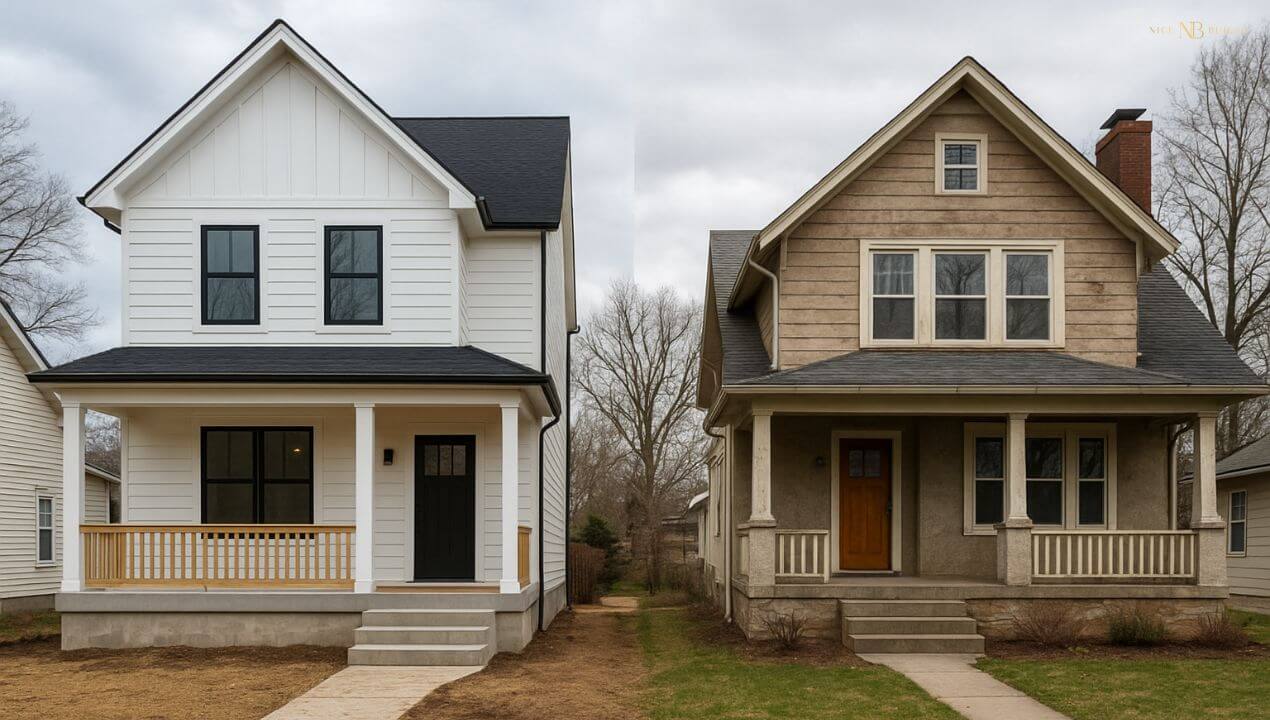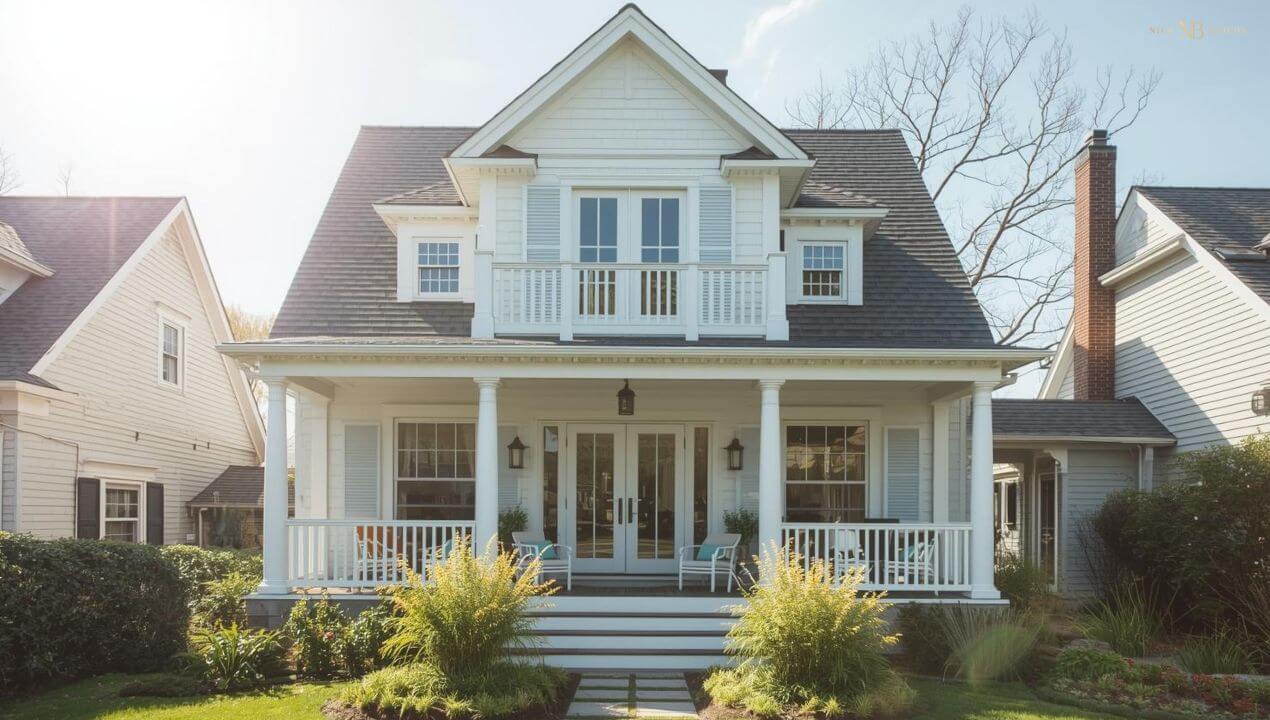Let’s say you’ve outgrown your old home, you have lived in the area for a long time and do not wish to move, but it’s also clear that you desperately need a change of scenery. What do you do? Break it all down and create something new from scratch, or tweak less or more of what you feel needs to be changed? Circumstances can be numerous. If not an old home, perhaps it’s an old property you’ve bought, and you need it to perform better. What do you think is the most plausible solution for your predicament?
Several factors can influence whether you should renovate or rebuild your home, such as cost, the extent of changes you envision, and the overall condition of your living space. Remodelling an old property often involves far more than repainting walls, replacing closets and cabinets, fixing roof shingles and eaves or updating bathroom fixtures. If you’re planning significant upgrades or a large-scale remodelling, renovating may prove impractical, like attempting to restore the shell of a home that’s already past its prime.
Rebuild delivers a clean slate, trendy design flexibility, and long-term efficiency through modernised materials, insulation, and energy-saving systems. However, it typically comes with higher upfront expenses and a more complex approval process.
That said, remodelling offers a unique advantage: it allows you to preserve the original charm and character of your home, which a complete rebuild cannot replicate. Renovating can also mean less disruption to your neighbourhood, faster timelines, and sometimes even lower costs compared to starting from scratch.
Understanding what entails a renovate vs rebuild, and making comparisons accordingly, will give you confidence when taking consultations and making the right choice for your dream home.
Renovate or Rebuild: Five key questions to consider before deciding
Whether you choose a knockdown rebuild or renovate largely depends on the condition of your current home, your budget, local council laws and your intentions. Renovating is a good choice if the structure of your home is sound and your goals are mostly cosmetic. It is usually faster and less expensive than starting from scratch. Rebuilding, on the other hand, is often the smarter option if the foundation or structure has serious issues, if you want a completely new layout or if the remodelling costs exceed the price of new construction.
Choosing whether to remodel or knock down and rebuild requires identifying your home’s specific needs. Taking time to evaluate each aspect will help specify the scope of your project.
Here’s a curated list of five essential issues to consider when mapping your future home:
What is the cost to renovate or rebuild?
Budget concerns are relevant, and apparently so, whether it be rebuilding or renovating, expenses can accumulate. Your budget ultimately guides your decisions and helps you prioritise your needs versus wants. Without careful planning and accurate cost calculations, unexpected financial challenges are likely to arise.
For remodelling, it’s crucial to clearly outline all the changes you want and set a realistic budget upfront. While they often appear more budget-friendly, unexpected issues such as hidden structural damage, outdated wiring, or plumbing complications can cause costs to escalate far beyond initial anticipation.
In contrast, a knockdown rebuild typically comes with a fixed budget. Your project manager or builder is responsible for providing you with a thorough quotation, so you know exactly what to expect and plan your finances accordingly.
If renovations are minor, costs are bearable; however, if the expense of repairs begins to approach that of a full rebuild, a knockdown rebuild is a wiser investment – offering better quality and less risk.

How much does it cost to rebuild a house?
The cost of building a new home can vary greatly depending on several factors, including location, the size and type of the existing home and the design and layout of the latest build. A total rebuild involves more than just construction; it begins with legal consultation, demolition, and sourcing labour and materials, among several other expenses. All these elements together contribute to the overall cost of the project.
In Australia, the cost of building generally ranges from $620 to $3,900, depending on factors, including location, design, materials and labour. In case of rebuilds, we need to consider more than just building the home, so it is estimated that the cost of a knockdown and rebuild ranges from $350,000 to over $700,000 for a standard home and more for luxury dwellings.
How much does it cost to renovate a house?
Renovations may be a smart choice; upgrading what you already have helps preserve the home’s originality while also providing an opportunity to add the elements it lacked. From a cost perspective, when the work is primarily superficial, remodelling is affordable. Owners can achieve desired results without breaking the bank.
The cost of remodelling, however, can vary significantly depending on several factors: the type of home being remodelled, the scale of changes and the type and quality of materials. The cost of renovation per square meter in Australia ranges from around $4,000 to $5,000. For more extensive projects or high-end finishes, the costs can increase considerably, so careful planning and budgeting are critical.
What is the age of your home?
For ageing homes that hardly serve their optimal purpose, your decision to renovate or rebuild can breathe new life into the property. For some owners, it may be about enhancing functionality, while for others, it’s about introducing modern comforts without renouncing the charm of the aged block. In either case, one of the most important factors to consider is the age and overall condition of the home.
Older homes carry craftsmanship and intricacy that’s rarely found in sleek modern builds today. Solid timber structures, high ceilings, and elaborate finishes are just a few examples of qualities that can’t be easily replicated. Preserving these aspects through renovation not only protects the character and history of the home but also allows modern adaptation, making it more practical, comfortable and efficient without sacrificing originality.
Read: Understand Standard Ceiling Height in Australia
However, when a property has reached the point of unreliability and sticks out awkwardly compared to the surroundings, a knockdown rebuild gives a sleeker solution. Starting fresh allows you to design a home tailored to your lifestyle while aligning with today’s standards. It also maximises the long-term value of both the house and the land, strengthening what would otherwise be a fragile foundation.
What is the condition of the existing home?
The condition of your existing home can directly affect your decision to rebuild or replace. Homes with strong foundations and structural integrity can be upgraded without major cost implications. Homes built on smooth land are easier to deal with than sloping blocks. However, for issues with compromised foundations, severe water and electrical damage, or widespread infestations, a rebuild is often the more practical choice. Repairing a bad structure can be extremely costly, and in many cases, you will only be covering up major issues that’ll soon resurface. Rebuilding helps eliminate the root of the problem and start fresh.
Repairs are ideal if you want to preserve the original aesthetic and architectural value of your home. For a structurally sound residence that only requires minor updates like repainting, fixing cabinetry, and restoring bathrooms, a knockdown rebuild may be unnecessary; remodelling for such concerns can be done at a fraction of the rebuilding cost.
Apart from just external conditions, the inner layout, floor plans and space are other factors that define your home. If it’s remained too small for your growing family and no longer meets your lifestyle needs, renovating can be both challenging and costly. In such cases, rebuilding provides a clean slate, allowing you to design a home that truly suits your requirements.
Recreating the exact look and feel of an older property is often difficult, if not impossible, with newer builds. Renovation is best when the bones of the house are strong, and its character is worth preserving. A knockdown rebuild makes sense when structural issues, layout challenges, or lifestyle demands outweigh the value of maintaining the old property.
Be fluent in architectural jargon, understand bulkheads to repurpose your boring home!
How much time can you invest?
Building a home involves several stages, and depending on the scale, it can take a significant amount of time to complete. Especially for working individuals or growing families, the remodelling process can be frustrating to endure, and rebuilding often tests your patience.
Remodelling requires workers in and around your home daily, which can feel intrusive. Unless you have the option of temporarily relocating, which means extra costs and inconvenience, you’ll likely be living in the middle of the construction zone. Constant noise, dust, and restricted access to areas in your own home can disrupt your routine. The exciting upgrade project soon turns demanding and problematic.
Want to experience classic coastal luxury? Find out everything you need to know about Hampton style homes!
However, rebuilding proves to be less of a hassle in this regard. Since the old house has been demolished, and work takes place entirely on your own land, you wouldn’t need to live in the mess. Clients can stay elsewhere while the construction is underway and make brief visits whenever possible. This makes it easier to distance yourself from daily troubles and focus on the joy of moving into a brand new home.

In terms of duration, homes in Australia are typically built in around 6 to 12 months; for complex designs and larger builds, time is adjusted accordingly. For an entire residence, this timeframe is perfectly fair, especially given that once the construction is finished, you can move straight in without much left to do.
Repairs often stretch out in phases, depending on the scope of work, the discovery of hidden issues or the need to work around client occupancy. This makes the time factor far less rewarding compared to a fresh build.
Also Read: First home Owner Grant QLD.
What is the state of the property market in your area?
A proper assessment of your property’s value is crucial to maximising market returns. Whether it’s a suburb or a city, residential homes have a definite impact. A home isn’t just where you live, but also a major financial asset that contributes to the character and overall worth of your neighbourhood.
The location of your home plays a significant role in asserting the value of your property. If you live near an influential area or a city with convenient access to sought-after amenities like schools, parks, malls and offices, staying put and investing in your property is advised. In such cases, a knockdown rebuild is a smart move; you can design a brand-new home to suit your needs, while still enjoying the benefits of your established, convenient location. It’s a way to refresh your lifestyle without sacrificing the advantages you already have.
In contrast, a full rebuild in underperforming suburbs for mere functional issues is hard to justify; a less expensive repair can make more financial sense. If your house is structurally sound and the problems are largely superficial, remodelling is usually the wiser option. You’ll enhance comfort and potentially increase property value without overspending in a market that can barely reward.
Another critical consideration is the risk of overcapitalisation. When the money you spend on remodelling or rebuilding exceeds the estimated profit or market value, your investment is void. A luxury home, no matter how impressive, in an area where property prices remain mediocre, could result in financial loss. To avoid this, local estate agents can provide valuable insights into market conditions, what’s selling, what’s struggling, and where buyer preferences are heading; they have incredible knowledge to offer. With their expertise, you can also make informed predictions about how the market may shift in the coming years.
Simple observation can also go a long way. Are your neighbours rebuilding or renovating? What layouts or design styles are they opting for? How’s the engagement with newly built homes around you? Paying attention to these trends helps you estimate the most beneficial improvements and practical investments.

Benefits of Renovation
Different homes have different needs, and not every situation calls for a complete rebuild. Renovations retain the core structure of the residence while addressing issues and making necessary adjustments. It ensures the original foundation of the home while giving it a fresh, modern touch. When problems with electrical supply, plumbing or worn-out interiors arise, opting for a full rebuild is impractical and costly. Remodelling encourages owners to resolve these problems efficiently without disturbing the structural integrity of the home. That said, the benefits of repairs aren’t limited to just finances and efficiency.
Cost-effective: Home finances can be tricky and demanding. In this economy, saving and wise investments are crucial means of survival. Remodelling is usually less expensive than rebuilding. They offer cost-effective solutions to household monotony, outdated designs and changing lifestyle needs.
Environment-friendly and sustainable: Renovations utilise existing structures and materials, reducing the need for new resources. This not only helps conserve natural resources but also lowers environmental impact by reducing waste.
Faster completion: Renovations take less time than full-scale reconstructions. It’s because they focus on updating rather than developing, owners can enjoy upgraded spaces sooner with a reduced project timeline.
Preserves character: When homes are remodelled, they are simply upgraded. With residences that hold history almost palpably in their layouts, it’s often a shame to demolish. When remodelling, homeowners can make the changes they want while preserving the home’s charm.
Benefits of Knockdown Rebuild
When the existing property is outdated, structurally compromised, or unable to meet the owner’s requirements, a knockdown rebuild is ideal. After demolishing an older property, a new one is built in its place. A change of scenery and lifestyle without needing to leave a comfortable location is one of the biggest advantages of a reconstruction. Free from the limitations and problems of an older residence that lead to several hidden costs, rebuilds are ideal for families seeking a modern, safe and habitable environment.
Fixed costs: A rebuild does not allow surprises; often, owners are provided an exact budget beforehand, and payments are made according to the contract. Unlike with repairs, hidden issues are rare since prior feasibility tests ensure mitigated risks.
Design freedom: When homes are being rebuilt, the clients have total freedom to customise. Designs can be drawn and amended as per the owner’s requirements. From foundations to finishing, there’s ultimate flexibility.
Learn more about Nice Build’s Custom Home Designs in Brisbane
Energy efficiency: Modern energy-saving technologies are scarce in older homes; such incorporations are much easier additions to new builds. This reduces utility costs and lowers long-term environmental impact.
Longevity and increased value: Rebuilt homes are brand new inside and out, with all issues eliminated, foundations redrawn, and structures refreshed; it’s a rebirth. These homes offer durability, reduced maintenance and repair costs and high resale value.
Renovate vs Rebuild: Making the right choice
To renovate your home or build it from scratch is one of the most important decisions a homeowner can make. Both options offer a variety of advantages, but the right choice depends on several factors such as the property, your budget, council approvals, lifestyle needs and long-term goals.
Renovation is suitable when the home is structurally sound and needs functional repair; demolition is a step too far in such circumstances. However, when foundations are weak and amenities are outdated, homes cease to serve the owner’s needs; that’s when a knockdown rebuild is ideal.
There’s a huge gap between what a home needs and what it wants. Set your priorities straight and avoid financial binds. Overcapitalising is a tumultuous issue. To minimise the risk, study your market performance, your indispensable needs and opt for the best returns and sustainability.
Ultimately, deciding between rebuilding or renovating comes down to balancing costs, personal preference, time and functionality. If a renovation can meet your needs, there’s no need to start from scratch; however, with larger changes and additions, renovations barely tap the surface. Homeowners should carefully weigh their options and circumstances to make a dimensioned choice.
Planning for a new home or want to better your old one? Nice Builds can be your one-stop solution. Book your consultation with the best home builder in Brisbane and begin your home building journey, today!
FAQ’s
What is the difference between rebuild and renovate?
A rebuild is an extensive process that begins with demolishing the existing home and constructing a brand-new structure in its place on the same site. That said, renovation focuses on upgrading and restoring the features of the current home while retaining its core framework.
Is it cheaper to rebuild a house or renovate?
It might come as a surprise that the choice between rebuilding and renovating is highly conditional. While rebuilds are often considered more expensive, both options are equally fluctuating. Renovations reveal hidden costs or unavoidable complications that can push the budget higher than expected. The cost of either option depends on the scale of the project and the extent of underlying problems.
Can you renovate your own house in Australia?
Depending on the scale of the project, homeowners can attempt minor renovations on their own; however, larger and more complex projects are best carried out with professional guidance.






